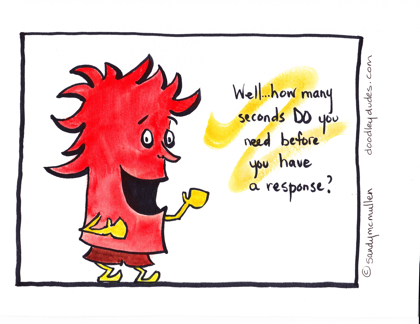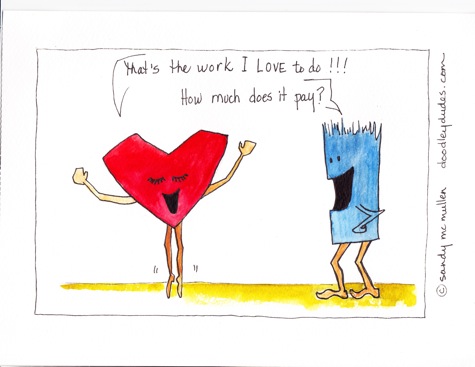
by Sandy | Aug 14, 2018 | Best Practices, MBTI Facts
Although my main interest in using assessment tools falls in the realm of understanding oneself, improving communication is another reason to embrace the information that the MBTI provides.
The basis of successful communication is rapport. Rapport occurs naturally when you feel in sync with another. We have all experienced those times when you can complete another’s thoughts and you just know that this person is “with” you. You can also see the rapport between others in social situations when people are turned toward each other heads titled at the same angle. While rapport occurs naturally when you feel that someone is “like” you are, it can also be helped along when you notice that you are out of sync.
At these times when you don’t have rapport the first thing to do is STOP trying to communicate the content of your message and get the alignment of rapport established. Without it the person is unlikely to hear you.
Here’s where you can consciously work with what you know about the MBTI. I have to admit that this is not my strong suit but I know that it is very helpful; for example, my husband has a preference for Sensing and my typical ENFP conversational style takes the kind of leaps that people with a preference for Intuition often make. When I notice that he has “gone to the beach” in his head because of my style I can focus on completing my story without all of my fascinating (to me) detours.
Shawn Bakker of Psychometrics Canada has a terrific article with tips to look for to recognize another’s MBTI preferences. You can use these signals to understand how to reestablish rapport if your style doesn’t match the other person’s preferred communication style. As an example Shawn points out that the person with a preference for Introversion may have a quieter voice. The Extravert can consider then adopting a quieter tone than they might use otherwise.
How you say things matters as much as what you say.
I’ll bet you have some conversational pet peeves – Love to hear what they are !!!!

by Sandy | Aug 14, 2018 | Best Practices, MBTI Facts
I love how entrepreneurs think and take action. The Ready, Fire, Aim approach they often take typically hits the mark even though occasionally it can cause some grief. However, when entrepreneurs get stuck and the momentum stalls, for whatever reason, it can get UGLY.
I was talking to such an entrepreneur (SP temperament) in such a stuck place who was finding it difficult to know what to say to clients who were complaining about something out of this individual’s control. People were making erroneous assumptions about this person’s working relationship with a business associate who was responsible for the problem area in question. This entrepreneur was like a deer in the headlights not knowing quite what to say because they had the inside scoop. However correcting any misconceptions about the division of responsibility would make both parties look bad and not satisfy the client. Besides which it would just feed any existing resentment by playing the BLAME game. The only responsible position was to take 100% responsibility to the client but it wasn’t pleasant.
My thinking went to a need for recreating the business agreements with this associate. This could have been a lengthy negotiation.
A third person (ENTJ) in the conversation suggested simply saying to the client “Thank you for your feedback. We will look into that and get back to you with some ideas.” I was quite taken aback for a moment until I realized that my approach could have been over-complicating things and possibly erecting even more barriers. This simple response would respect the client and provide an opportunity for the entrepreneur to maintain their momentum.
In focusing on providing for the client these associates might have an opportunity for some honest conversation to sort out their relationship from the bottom up. It might not require a big formal re-negotiation if a series of smaller conversations could achieve the same result.
Are you aware of areas where you over-complicate matters?

by Sandy | Aug 12, 2018 | MBTI Facts
During a conversation with an Extraverted salesperson who did not know the Myers Briggs Type Indicator, I described the differences between Introversion and Extraversion and the internal processing of those with a preference for Introversion.
At first a look of surprise crossed their face and this was followed by an immediate aha moment. They went on to describe a conversation that had just occurred that morning with a client. The salesperson had been using discovery questions to explore the needs of this client and was getting MUCH MORE silence than response. The silence compelled the salesperson to push – asking even more questions. As this Extravert listened to me describe how the Introvert has a dominant function that is in the internal world not the external, they suddenly were able to reframe the clients behaviour from “being difficult (on purpose)” to being the Introvert’s natural way of reflecting before speaking. They were thrilled to have the suggestion to give the person time to reflect before pushing for an answer before the person has had a moment to ponder their response

by Sandy | Aug 12, 2018 | MBTI Facts, Other Personality Assessments
My first response to this question about Extroverts capability to listen was an automatic and very vocal ABSOLUTELY.
In saying that I recognize that the MBTI simply looks at preferences and not capability but it can also point out potential “blindspots” and “By George” I think I just discovered one.
Lesley Parrott, queen of the Insights Discovery inventory, a preference based system built on the work of Jung, very kindly pointed out that Extroverts often want to align with others and this can affect how they listen. She want on to demonstrate the LISTEN and ADD technique
Person A – I had this awesome life shattering experience trekking in the Himalayas (Or whatever else the topic may be)
Person E for Extrovert (adds without a breath in between) I know I know when I backpacked through Poughkeepsie yada yada….
I blushed because I am SO guilty of doing that. I sometimes approach conversation as if it was improv.
Lesley went on to identify how great radio interviewers such as the late great Canadian host Peter Gzowski could ask a question and then let it sit out there in silence giving the person a chance to answer.
The secret to listening … SHUT UP and WAIT for a response or continuation of the thought.
Can you leave “dead” air? What are the chances you might hear something that you might have missed if you filled the void?

by Sandy | Aug 12, 2018 | Best Practices, MBTI Facts
When someone is talking from their ideals, from their heart, a quick thrust to the bottom line can be a jolt and can seem abrasive. Here’s a tip for uber-analytical types
“When someone is waxing enthusiastically, soften the delivery if you want to be heard.”

by Sandy | Aug 8, 2018 | Best Practices, MBTI Facts
Imagine a work environment where everyone has their MBTI type label posted on their office door. This may strike some as just terribly efficient. But no No NO NOOOOO…this is just bad practice and a misuse of the MBTI or any other assessment tool IMHO.
People are NOT any label that you might hang on them, and this way of viewing the use of assessment tools does a disservice to everyone. MBTI professionals are very careful in their language to make the distinction. They will talking about “those with a preference for Extraversion” as opposed to “those who ARE Extraverts”. People are wonderfully complex and they definitely should not be limited by any label. People HAVE a preference – they AREN’T their preference. This distinction matters.
When you hang a sign on a door that limits possibilitites for genuine engagement. People can make all kinds of false assumptions based on too little information and misunderstanding. It is an act that separates us from each other rather than building true connection and compassion.
Knowing that someone may have a different type helps me to understand how they process information and make decisions differently from my way of being. I don’t have to take their behaviour as a problem or weird or even better than mine – simply different. If I spend some time observing myself I may even come to appreciate the benefit of how their type handles some situations where my way of processing may have blind spots.
Yes – use the MBTI to learn how to communicate with other styles. Yes – use the MBTI to find work that fits your natural ways of being. Yes – use the MBTI to learn to see and appreciate each other and to share in a way that builds trust. This approach involves real conversation about our different perspectives and a desire to learn and understand those with whom we work. Putting type labels on office doors may do the opposite – contributing to judgment and alienation. Don’t do it even if you think people will be okay with it – it may seem harmless but it isn’t.
Other folks had something to say about this too:
From Hunter Nuttal
Forcing people to post their MBTI type on their doors would surely be resisted by a lot of people. I’d like it personally, but many people freak out about being labeled.
Notice that we only mind labels when they’re negative. Face it, we couldn’t communicate without labels. We label ourselves with names and job titles, we say “I’m a motorcycle enthusiast” or “I’m a pizza lover,” we like it when people call us “smart” or “nice.”
All these labels are fine, but call someone by a label that sounds negative, and they’ll suddenly be all “Don’t label me!” As the MBTI labels are simply about our preferences, none of them are bad. It doesn’t make sense to be offended by your own preferences.
I think people resist these labels because they don’t understand them. They think that learning your type somehow limits your options, or tells you that you’re bad at something. Nonsense. Knowledge is power.
Another thing is that everyone is labeling us anyway. Remaining ignorant about our type will do nothing to protect us from peoples’ negative judgments. I’d much rather be called an INTP by someone who’s been educated about the MBTI, rather than be called “shy,” “flaky,” “heartless,” or “lazy” by uninformed people.
BTW, I’m building a list of peoples’ self-reported MBTI types. My URL points directly to that, if you want to take a look.
From Stephen
James Flaherty, in “Coaching – Evoking Excellence in Others”, points out that personality profiling leads us to expect certain behaviours from others which influences that person’s behaviour and frames our observation of that person. And these two factors, coupled with laziness leads us into one of the main hindrances of coaching, which is to understand people as a collection for fixed properties with desire attached.
In the book he proposes assessment models which he claims give form and shape to our observations without limiting the person to parameters.
The idea of putting MBTI labels on office doors is exactly what he is highlighting. It is easier to say – “She is an ISTJ” than it is to understand and formulate a view of her concerns, commitments, history, future possibilities, mood, domains of competence, Intellect, emotion, will, context and soul (to outline JF’s assessment models).
I have used MBTI in exercises with teams, allowing people to comment and draw comment on what they agree with and what they don’t. In my experience this has provided an excellent framework, for mutual understanding. In coaching however I have started using JF’s (and others’) approach. Having said that, I also know that MBTI takes us to the same understanding if we are prepared to do the hard work required to get beyond a tetragrammaton.
Sandy, what process do you build into your work to prevent the kind of response you describe in this posting?
From Me
A few things come to mind about how I work with the MBTI with people. First is that I have a commitment and intention behind my coaching practice. I believe that we do the best most fulfilling creative and sustainable work when our actions are congruent with who we are.
Tools like the MBTI and Enneagram and Reiss are mirrors to use to see a more accurate reflection. All of this happens in the context of a conversation that has a purpose behind it.
For example, any MBTI workshops that I have done as an associate of Context Management Consulting Inc. have been part of a larger strategic framework. Context works to implement strategy through ongoing Action Learning groups in cross functional teams as well as regular retreats for intact teams etc. The MBTI workshops were integrated into these retreats when appropriate and linked to a larger context.
In additon to the workshop individual coaching followed. Some of the focus integrated the Hay groups Emotional Competency Inventory and the insights from the MBTI to help deepen the learning and build capability.
Two things stand out – that the MBTI was part of a leadership development strategy – that there was both a group and individual opportunity for reflection on applying insights.
It was not delivered as a “one off” event that was entertaining or interesting. As I mentioned in my post above I am also careful with language and asking permission to share personal information during the workshop or coaching. My intention is to set the stage for people to take the risks to have a more meaningful conversation (a least that’s the plan) Creating this kind of container for good work to happen is subtle and an art form. When it happens I celebrate when it doesn’t I learn and go on.





